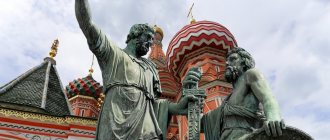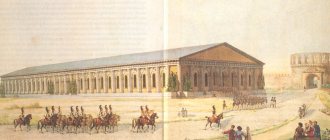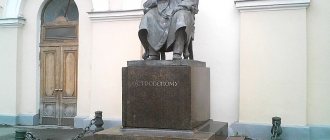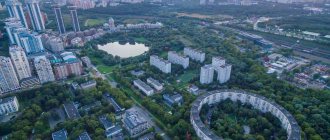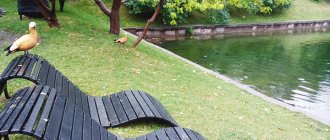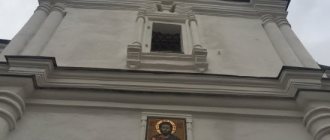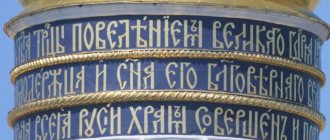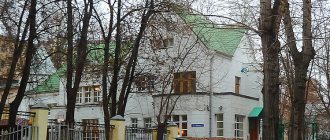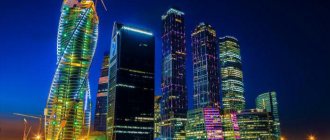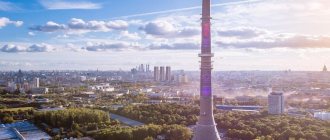Minin and Pozharsky are figures from one of the most difficult periods of Russian history, that is, the Time of Troubles at the beginning of the 17th century. They became the organizers of the Second Zemstvo Militia, which liberated Moscow from Polish invaders in the fall of 1612. To understand the history of Russia during the Time of Troubles at the beginning of the 17th century, you should know who Minin and Pozharsky are, what these figures are famous for and what they did for Russia. Their biographies are briefly studied in the school history course of grades 7 and 10.
Biography of Minin
The exact date of his birth is unknown; most likely, he was born in the city of Balakhna near Nizhny Novgorod in the family of a Tatar salt worker, Mina Ankudinov, in the 1570s.
Rice. 1. Kuzma Minin.
A friend of his family was Prince Pozharsky. At the beginning of the 17th century, he opened a shop in Nizhny Novgorod and began trading livestock and meat. In 1608–1610, he found himself as part of the city militia, which was loyal to Tsar Vasily Shuisky, and therefore fought with supporters of the impostor False Dmitry II. It was then that the Nizhny Novgorod residents gained their first combat experience and defeated the supporters of the impostor, the Tushins.
His biography has been known relatively well since the fall of 1611. He became the zemstvo elder. The militia, together with him and Prince Pozharsky, was led by Archpriest Savva. Minin was responsible for the economic part of the militia. For the needs of the militia, from a fifth to a third of the property of the townspeople was taken away, and if someone refused, they were deprived of their property completely and became a slave.
In 1612, the militia was formed and set off to liberate Moscow along the road through Yaroslavl. Minin joined the temporary government body - the Council of the Whole Land. He took part in the battles with the Poles in the fall of 1612 and later enjoyed great confidence from Tsar Mikhail Romanov. Minin died in 1616.
Rice. 2. Dmitry Pozharsky.
Second zemstvo militia
Little is known about the beginning of the zemstvo militia that liberated Moscow. The date of Minin's famous speech is unknown, as are the reasons for his speech. The letters from the clergy did not call for the convening of a new militia. Kuzma Minin was influenced by the very life and mood of the people - indignation, despair and hope in God.
All that remained was to obtain the support of the governor and the higher clergy. The clergy was opposed to the Poles. The first governor, Vasily Zvenigorodsky, looked towards the Boyar Duma.
Minin spoke to the people in the middle - second half of October 1611. Nizhny Novgorod residents pledged to donate to the militia “their belongings and trades.” Minin was chosen to be responsible for collecting money—the “salary man.” But the residents of Nizhny Novgorod chose Prince Dmitry Pozharsky as the governor of the new militia.
The militia received a generous salary - from 50 to 30 rubles. The chronicler writes that Minin “quenched the thirsty hearts of the warriors, and covered their nakedness, and gave them peace in everything, and with these deeds he gathered a considerable army.” According to Zabelin, “this was Minin’s main and great merit; This was where his far-sighted, practical mind was revealed. He understood well that no dictatorial sentences and no patriotic inspiration would have gathered military men if they had nothing to eat or had a meager life.”
From the very beginning, there was complete understanding and agreement between Pozharsky and Minin. One dealt with the military side of the matter, the other with providing troops.
In the spring of 1612, Pozharsky’s army cleared Zamoskovye of Cossack gangs.
In May 1612, the Yaroslavl embassy began negotiations in Novgorod with Metropolitan Isidore and the Swedish governor Jacob Delagardie. Negotiations lasted more than two months. On July 26, the parties agreed to sign a truce between the Moscow and Novgorod states.
Pozharsky set out from Yaroslavl on July 27, the day after the agreement with Novgorod was approved. The army with cannons and convoys moved slowly and on July 29 were still 29 miles from the city.
On August 14, the militia came to the walls of the Trinity and were solemnly greeted by Archimandrite Dionysius and the brethren. Pozharsky spoke from Trinity on August 18.
All day on August 20, Pozharsky’s army settled in, preparing for the arrival of Khodkevich. The militia settled along the rampart of the western side of Zemlyanoy Gorod or Skorodom, which surrounded the White City in a ring. Khodkevich did not keep himself waiting. On August 21, he set up camp on Poklonnaya Hill, six miles from Pozharsky’s positions.
Biography of Pozharsky
Prince Dmitry Pozharsky was born in November 1578, probably in Klinsky district near Moscow. He began his service in 1593, and at the beginning of the reign of Boris Godunov, that is, in 1598, he received a court rank and became a solicitor.
Under Tsar Vasily Shuisky, in 1606–1609, he took part in the fight against the rebels of Ivan Bolotnikov and supporters of False Dmitry II. In 1609, he became a governor in Zaraysk, and in 1611 he took part in the First Zemstvo Militia, which tried to liberate Moscow from the Poles. Despite a number of successes, the militia failed, and the prince was wounded and taken to Nizhny Novgorod for treatment. At the turn of 1611–1612, he took part in the creation of the Second Zemstvo Militia, which in the spring and summer made a campaign from Nizhny Novgorod to Moscow through Kostroma and Yaroslavl.
In 1613–1618, he took part in the war with the Polish-Lithuanian Commonwealth and in diplomatic negotiations with the British. After 1618, the prince managed to lead the Yamsky, Robbery and Local orders, and also serve as a governor in Nizhny Novgorod and a governor in Suzdal. In 1640 he took part in negotiations with the Poles, and in 1642 he died.
The most famous monument to Minin and Pozharsky was erected in Moscow on Red Square in 1818. Later, monuments appeared in Yaroslavl, Nizhny Novgorod, Suzdal and Zaraysk. During the Second World War, armored trains were named after them, and at the beginning of the 20th century, ships of the Imperial Navy were named after them.
Rice. 3. Minin and Pozharsky.
How Minin and Pozharsky created the Second People's Militia
The collapse of the First Zemstvo Militia did not lead to the end of Russian resistance.
By September 1611, a militia was formed in Nizhny Novgorod. It was headed by the Nizhny Novgorod zemstvo elder Kuzma Minin, who invited Prince Dmitry Pozharsky to command military operations. In February 1612, the Second Militia set out on a campaign to the capital. Nizhny Novgorod
At the beginning of the 17th century, Nizhny Novgorod was one of the largest cities of the Russian kingdom. Having emerged as a border fortress of Vladimir-Suzdal Rus' on its eastern border, it gradually lost its military significance, but acquired serious trade and craft significance. As a result, Nizhny Novgorod became an important administrative and economic center in the Middle Volga. In addition, in Nizhny there was a rather large and quite heavily armed “stone city”; its upper and lower settlements were protected by wooden forts with towers and a moat. The garrison of Nizhny Novgorod was relatively small. It consisted of approximately 750 archers, fodder foreigners (mercenaries) and serf servants - gunners, collars, zatinshchiki and state blacksmiths. However, this fortress could become the core of a more serious army.
Its important geographical location (it was located at the confluence of the two largest rivers of inland Russia - the Oka and the Volga) made Nizhny Novgorod a major trading center. In terms of its trade and economic significance, Nizhny Novgorod stood on a par with Smolensk, Pskov and Novgorod. In terms of its economic importance, it occupied sixth place among Russian cities at that time. So, if Moscow gave the royal treasury 12 thousand rubles in customs duties at the end of the 16th century, then Nizhny - 7 thousand rubles. The city of Rod was connected with the entire Volga river system and was part of the ancient Volga trade route. Fish from the Caspian Sea, furs from Siberia, fabrics and spices from distant Persia, and bread from the Oka River were brought to Nizhny Novgorod. Therefore, the main importance in the city was the trading area, in which there were up to two thousand households. There were also many artisans in the city, and in the river port there were workers (loaders and barge haulers). Nizhny Novgorod Posad, united into a zemstvo world headed by two elders, was the largest and most influential force in the city.
Thus, Nizhny Novgorod, in terms of its military-strategic position, economic and political significance, was one of the key points in the eastern and southeastern regions of the Russian state. It was not for nothing that the 16th century publicist Ivan Peresvetov advised Tsar Ivan the Terrible to move the capital to Nizhny Novgorod. It is not surprising that the city became the center of the people's liberation movement, which swept the Upper and Middle Volga regions and neighboring regions of Russia, and Nizhny Novgorod residents actively participated in the struggle for the liberation of the Russian state.
Nizhny Novgorod and Time of Troubles
During the Time of Troubles, Nizhny Novgorod was repeatedly threatened with ruin by the Poles and Tushins. At the end of 1606, large gangs appeared in the Nizhny Novgorod district and adjacent districts, which were engaged in robberies and outrages: they burned villages, robbed residents and drove them away into captivity. This “freedom” captured Alatyr and Arzamas in the winter of 1608, establishing its base there. Tsar Vasily Shuisky sent his commanders with troops to liberate Arzamas and other cities occupied by “thieves”. One of them, Prince Ivan Vorotynsky, defeated rebel detachments near Arzamas, took the city and cleared the areas adjacent to Arzamas.
With the arrival of False Dmitry II, various gangs became active again, especially since part of the boyars, Moscow and district nobility and the boyars' children went over to the side of the new impostor. The Mordovians, Chuvashs and Cheremis also rebelled. Many cities also went over to the side of the impostor and tried to persuade Nizhny Novgorod to do so. But Nizhny Novgorod stood firmly on the side of Tsar Shuisky and did not change his oath to him. Nizhny Novgorod residents never allowed enemies into the city. Moreover, Nizhny not only successfully defended itself, but also sent its army to help other cities and supported Skopin-Shuisky’s campaign.
So, when at the end of 1608 the residents of the city of Balakhna, betraying their oath to Tsar Shuisky, attacked Nizhny Novgorod, governor Andrei Alyabyev, following the verdict of the Nizhny Novgorod residents, struck the enemy, and on December 3, after a fierce battle, he occupied Balakhna. The rebel leaders were captured and hanged. Alyabyev, barely having time to return to Nizhny, again entered the fight with a new enemy detachment that attacked the city on December 5. Having defeated this detachment, the Nizhny Novgorod residents took Vorsma.
At the beginning of January 1609, Nizhny was attacked by the troops of False Dmitry II under the command of the governor Prince Semyon Vyazemsky and Timofey Lazarev. Vyazemsky sent a letter to the people of Nizhny Novgorod, in which he wrote that if the city did not surrender, then all the townspeople would be exterminated and the city would be burned to the ground. The Nizhny Novgorod residents did not give an answer, but decided to make a sortie themselves, despite the fact that the enemy had more troops. Thanks to the surprise of the attack, the troops of Vyazemsky and Lazarev were defeated, and they themselves were captured and sentenced to hang. Then Alyabyev liberated Murom from the rebels, where he remained as a royal governor, and Vladimir.
The people of Nizhny Novgorod waged an even more active struggle against the Polish troops of King Sigismund III. Simultaneously with Ryazan, Nizhny Novgorod called on all Russians to liberate Moscow. It is interesting that letters with such appeals were sent out not only on behalf of the governors, but also on behalf of the townspeople. The importance of urban settlements in the fight against enemy intervention and internal unrest has increased significantly. On February 17, 1611, earlier than others, the Nizhny Novgorod squads marched to Moscow and bravely fought under its walls as part of the First Zemstvo Militia.
The failure of the first militia did not break the will of the Nizhny Novgorod residents to resist; on the contrary, they became even more convinced of the need for unity for complete victory. Nizhny Novgorod residents maintained constant contact with Moscow through their spies - the boyar son Roman Pakhomov and the townsman Rodion Moseev. They penetrated the capital and obtained the necessary information. Nizhny Novgorod spies even managed to establish contact with Patriarch Hermogenes, who was languishing in the Kremlin in an underground cell of the Chudov Monastery. Gonsevsky, embittered by the fact that the patriarch denounced the interventionists and their henchmen, called on the Russian people to fight and, not daring to openly deal with Hermogenes, sentenced him to death by starvation. Once a week, only a sheaf of unthreshed oats and a bucket of water were given to the imprisoned for food. However, this did not humble the Russian patriot. From the underground dungeon, Hermogenes continued to send out his letters calling for the fight against the invaders. These letters also reached Nizhny Novgorod.
Minin
From Nizhny, in turn, letters were distributed throughout the country with a call to unite to fight a common enemy. In this strong city, the determination of the people to take the fate of the dying country into their own hands was maturing. It was necessary to inspire the people, to instill in people confidence in victory, and a willingness to make any sacrifices. People were needed who had high personal qualities and such an understanding of what was happening to lead the popular movement. A simple Russian man from Nizhny Novgorod, Kuzma Minin, became such a leader, a national hero.
Little is known about Minin's origins. However, it is known for sure that the version about the non-Russian origin of K. Minin (“baptized Tatar”) is a myth. On September 1, 1611, Minin was elected to the zemstvo eldership. “The husband is not famous by birth,” notes the chronicler, “but he is wise, intelligent and pagan in meaning.” The people of Nizhny Novgorod were able to appreciate Minin’s high human qualities when they nominated Sukhoruk to such an important post. The position of zemstvo elder was very honorable and responsible. He was in charge of collecting taxes and administered court in the settlement, and had great power. The townspeople had to obey the zemstvo elder “in all worldly matters,” and he had the right to force those who did not obey. Minin was a “favorite” person in Nizhny for his honesty and justice. Great organizational talent, love for the Motherland and ardent hatred of the invaders promoted him to the “fathers” of the Second Zemstvo Militia. He became the soul of the new militia.
Minin began his exhortations to “help the Moscow state” both in the “zemstvo hut”, and at the market where his shop stood, and near his house in ordinary meetings of neighbors, and at gatherings where letters that came to Nizhny Novgorod were read to the townspeople, etc. .d. In October 1611, Minin appealed to Nizhny Novgorod residents to create a people's militia to fight foreigners. At the sound of the alarm, people came to the Transfiguration Cathedral for a gathering. Here Kuzma Minin made his famous speech, in which he convinced the people of Nizhny Novgorod not to spare anything for the defense of their native country: “Orthodox people, we want to help the Moscow state, we will not spare our bellies, and not just our bellies - we will sell our yards, we will pawn our wives and children and we will beat brow, so that someone becomes our boss. And what praise will all of us receive from the Russian land that such a great thing will happen from such a small city as ours. I know that as soon as we move towards this, many cities will come to us, and we will get rid of the foreigners.”
Kuzma Minin's ardent appeal received the warmest response from Nizhny Novgorod residents. On his advice, the townspeople gave “third money,” that is, a third of their property, for the militia. Donations were made voluntarily. One rich widow donated 10 thousand out of 12 thousand rubles she had - a huge amount at that time, striking the imagination of Nizhny Novgorod residents. Minin himself donated not only “his entire treasury” to the needs of the militia, but also silver and gold frames from icons and his wife’s jewelry. “You all should do the same,” he told Posad. However, voluntary contributions alone were not enough. Therefore, a forced collection of “fifth money” was announced from all Nizhny Novgorod residents: each of them had to contribute a fifth of their income from fishing and trading activities. The money collected was to be used to distribute salaries to serving people.
Peasants, townspeople and nobles volunteered to join the Nizhny Novgorod militia. Minin introduced a new order in the organization of the militia: the militia were given a salary that was not equal. Depending on their military training and military merits, the militias were divided into four salaries. Those on the first salary received 50 rubles a year, on the second - 45, on the third - 40, on the fourth - 35 rubles. A cash salary for all militia members, regardless of whether they were a townsman noble or a peasant, made everyone formally equal. It was not nobility of origin, but skill, military abilities, and devotion to the Russian land that were the qualities by which Minin assessed a person.
Kuzma Minin not only himself was attentive and sensitive to every soldier who joined the militia, but also demanded the same from all commanders. He invited a detachment of serving Smolensk nobles into the militia, who, after the fall of Smolensk, not wanting to serve the Polish king, abandoned their estates and went to the Arzamas district. The residents of Nizhny Novgorod greeted the arriving Smolensk soldiers very warmly and provided them with everything they needed.
With the full consent of all residents and city authorities of Nizhny Novgorod, on the initiative of Minin, the “Council of the Whole Earth” was created, which became by its nature the provisional government of the Russian state. It included the best people of the Volga region cities and some representatives of local authorities. With the help of the “Council”, Minin recruited warriors into the militia and resolved other issues. The residents of Nizhny Novgorod unanimously bestowed on him the title “elected person by the whole earth.”
Minin's appeal to the people of Nizhny Novgorod in 1611. M. I. Peskov
Commander of the Second Militia
An extremely important question was: how to find a governor who would lead the zemstvo militia? Nizhny Novgorod residents did not want to deal with local governors. Okolnichy Prince Vasily Zvenigorodsky was not distinguished by military talents, and was related to Mikhail Saltykov, hetman Gonsevsky’s henchman. He received the rank of okolnik by charter from Sigismund III, and was appointed to the Nizhny Novgorod voivodeship by Trubetskoy and Zarutsky. There was no trust in such a person.
The second governor, Andrei Alyabyev, fought skillfully and served faithfully, but was known only in his own, Nizhny Novgorod, district. The townspeople wanted a skilled governor, not a commander, and well-known among the people. Finding such a governor in these troubled times, when the transitions of governors and nobles from one camp to another became commonplace, was not easy. Then Kuzma Minin proposed to elect Prince Dmitry Mikhailovich Pozharsky as governor.
Nizhny Novgorod residents and militias approved his candidacy. A lot spoke in favor of the prince: he was far from the corrupt ruling elite, did not have a Duma rank, and was a simple steward. He failed to make a court career, but he distinguished himself more than once on the battlefield. In 1608, being a regimental commander, he defeated the Tushin troops near Kolomna; in 1609 he defeated the gangs of Ataman Salkov; in 1610, during the dissatisfaction of the Ryazan governor Prokopiy Lyapunov with Tsar Shuisky, he kept the city of Zaraysk in allegiance to the tsar. Then he defeated the Polish detachment sent against Lyapunov and the “thieves’” Cossacks, who tried to take Zaraisk. He was faithful to his oath and did not bow to foreigners. The fame of the prince's heroic deeds during the Moscow uprising in the spring of 1611 reached Nizhny Novgorod. The residents of Nizhny Novgorod also liked such traits of the prince as honesty, selflessness, fairness in making decisions, decisiveness and balance in his actions. In addition, he was nearby, he lived on his estate just 120 versts from Nizhny. Dmitry Mikhailovich was undergoing treatment after severe wounds received in battles with enemies. The wound on his leg was especially difficult to heal—the lameness remained for life. As a result, Pozharsky received the nickname Lame.
To invite Prince Dmitry Pozharsky to the voivodeship, Nizhny Novgorod residents sent an honorary embassy to the village of Mugreevo, Suzdal district. There is information that before and after this Minin visited him several times, together they discussed issues of organizing the Second Zemstvo Militia. Nizhny Novgorod residents went to see him “many times so that I could go to Nizhny for the Zemstvo Council,” the prince himself noted. As was customary then, Pozharsky refused the offer from Nizhny Novgorod for a long time. The prince understood perfectly well that before deciding on such an honorable and responsible task, it was necessary to think carefully about this issue. In addition, Pozharsky wanted from the very beginning to receive the powers of a great governor, to be commander-in-chief.
In the end, Dmitry Pozharsky, who had not yet fully recovered from his wounds, gave his consent. But he also set the condition that the residents of Nizhny Novgorod themselves choose from among the townspeople a person who would join him at the head of the militia and deal with the “rear.” And he proposed Kuzma Minin for this position. That's what they decided on. Thus, in the zemstvo militia, Prince Pozharsky took on the military function, and the “elected person by the whole earth” Kuzma Minin-Sukhoruk began to manage the army’s economy and the militia treasury. At the head of the second zemstvo militia were two people elected by the people and invested with their trust - Minin and Pozharsky.
"Minin and Pozharsky." Painter M. I. Scotti
Militia organization
At the end of October 1611, Prince Pozharsky with a small retinue arrived in Nizhny Novgorod and, together with Minin, began organizing the people's militia. They developed vigorous activity to create an army that was supposed to liberate Moscow from the invaders and begin the expulsion of the interventionists from Russian soil. Minin and Pozharsky understood that they could solve such a great task facing them only by relying on the “nationwide multitude.”
Minin showed great firmness and determination in raising funds. Minin demanded that the militia tax collectors not make concessions to the rich, and not unfairly oppress the poor. Despite the general taxation of Nizhny Novgorod residents, there was still not enough money to provide the militias with everything they needed. We had to resort to forced loans from residents of other cities. The taxation was imposed on the clerks of the richest merchants, the Stroganovs, merchants from Moscow, Yaroslavl and other cities connected by trade with Nizhny Novgorod. By creating the militia, its leaders began to show their strength and power far beyond the borders of the Nizhny Novgorod district. Letters were sent to Yaroslavl, Vologda, Kazan and other cities. A letter sent out on behalf of the Nizhny Novgorod militia to residents of other cities said: “From all the cities of the Moscow state, nobles and boyar children were near Moscow, Polish and Lithuanian people were besieged by a strong siege, but a stream of nobles and boyar children from near Moscow dispersed for a temporary sweets, for robbery and kidnapping. But now we, all kinds of people of Nizhny Novgorod, having exiled ourselves to Kazan and all the cities of the lower and Volga regions, having gathered with many military people, seeing the final ruin of the Moscow state, asking God for mercy, we are all going with our heads to help the Moscow state. Yes, the people of Smolensk, Dorogobuzhan and Vetchan came to us in Nizhny from Arzamas... and we, all sorts of people of Nizhny Novgorod, having consulted among ourselves, decided: to share our bellies and houses with them, to give a salary and help, and to send them to help the Moscow State." .
The Volga region cities responded to the call of Nizhny Novgorod in different ways. Small towns such as Balakhna and Gorokhovets immediately got involved. Kazan reacted to this call rather coolly at first. Its “sovereign people” believed that “royal Kazan, the main city of the Ponizov region,” should take precedence. As a result, the core of the militia, along with the Nizhny Novgorod residents, became the service people of the border regions who arrived in the vicinity of Arzamas after the fall of Smolensk - Smolyan, Belyan, Dorogobuzhan, Vyazmichi, Brenchan, Roslavtsy and others. About 2 thousand of them gathered, and all of them were experienced fighters who had participated in battles more than once. Subsequently, nobles from Ryazan and Kolomna, as well as service people, Cossacks and archers from the “Ukrainian cities” who sat in Moscow under Tsar Vasily Shuisky, came to Nizhny.
Having learned about the formation of the Second Militia in Nizhny Novgorod and not being able to counteract it, the concerned Poles turned to Patriarch Hermogenes demanding that he condemn the “traitors.” The Patriarch refused to do this. He cursed the Moscow boyars who turned to him on Gonsevsky’s instructions as “damned traitors.” As a result, he was starved to death. On February 17, 1612, Hermogenes died.
The leaders of the second militia needed to resolve the issue of the remnant of the First militia. The leaders of the Cossack freemen, Zarutsky and Trubetskoy, still had significant strength. As a result, since December 1611, two provisional governments operated in Russia: the “Council of All the Land” of the Moscow Cossacks, led by Ataman Ivan Zarutsky, and the “Council of the Whole Land” in Nizhny Novgorod. Between these two centers of power there was a struggle not only for influence on local governors and for income, but also over the question of what to do next. Zarutsky and Trubetskoy, with the support of the rich and influential Trinity-Sergius Monastery, proposed to lead the militia to Moscow as quickly as possible. They feared the rapid growth of power and influence of the Nizhny Novgorod army. And they planned to take a dominant position near Moscow. However, the “Council of All the Earth” of Nizhny Novgorod considered it necessary to wait in order to properly prepare for the campaign. This was the line of Minin and Pozharsky.
The relationship between the two centers of power became openly hostile after Trubetskoy and Zarutsky began negotiations with the Pskov impostor Sidorka (False Dmitry III), to whom they eventually swore allegiance. True, they soon had to abandon their “kissing of the godfather,” since such an act did not find support among ordinary Cossacks and was sharply condemned by Minin and Pozharsky.
Start of the hike
After hard work, by the beginning of February 1612, the Nizhny Novgorod militia was already an impressive force and reached 5 thousand soldiers. Despite the fact that the work on the military structure of the Second Militia had not yet been completely completed, Pozharsky and Minin realized that they could no longer wait and decided to start the campaign. Initially, the shortest route was chosen - from Nizhny Novgorod through Gorokhovets, Suzdal to Moscow.
The moment for the attack was convenient. The Polish garrison located in Moscow experienced great difficulties, especially an acute shortage of food. Hunger forced most of the Polish garrison to leave the devastated city to the surrounding counties in search of food. Out of 12 thousand There were approximately 4,000 enemy troops left in the Kremlin and Kitai-Gorod. garrison weakened by hunger. The most selected detachments of Polish thugs under the command of Hetman Chodkiewicz were located in the village of Rogachevo near the city of Dmitrov; Sapieha's detachment was in the city of Rostov. There was no help from Sigismund III for the besieged garrison. But the “Seven Boyars” did not represent any real military force. Thus, this was the most convenient time for the liberation of Moscow.
Voivode Dmitry Pozharsky drew up a plan for the liberation campaign. The idea was to take advantage of the fragmentation of the interventionist forces and break them up piece by piece. At first it was planned to cut off the detachments of Khodkiewicz and Sapieha from Moscow, and then defeat the besieged Polish garrison of Gonsevsky and liberate the capital. Pozharsky hoped for help from the Cossack “camps” near Moscow (remnants of the First Militia).
However, Ataman Zarutsky began open hostile actions. He decided to capture a number of large cities in North-Eastern Rus' and thereby prevent Nizhny Novgorod residents from entering there and maintain his sphere of influence. Taking advantage of the withdrawal of the Great Detachment of Sapieha from Rostov, Zarutsky in February ordered his Cossacks to capture Yaroslavl, a strategically important Volga city. The Cossack detachment of Ataman Prosovetsky was supposed to head there from Vladimir.
As soon as Zarutsky’s actions became known, Minin and Pozharsky were forced to change the original plan for the liberation campaign. They decided to move up the Volga, occupy Yaroslavl, bypassing the devastated areas where the Cossack detachments of Zarutsky and Trubetskoy, located near Moscow, were operating, and unite the forces that rose up against the interventionists. Zarutsky's Cossacks were the first to break into Yaroslavl. The townspeople asked Pozharsky for help. The prince sent detachments of his relatives, princes Dmitry Lopata Pozharsky and Roman Pozharsky. They quickly occupied Yaroslavl and Suzdal, taking the Cossacks by surprise and did not allow Prosovetsky’s troops there. Prosovetsky’s detachment, which was on the way to Yaroslavl, had no choice but to turn back to the camps near Moscow. He did not accept the fight.
Having received news from Lopata-Pozharsky that Yaroslavl was in the hands of Nizhny Novgorod, Minin and Pozharsky at the beginning of March 1612 gave the order to the militia to set out from Nizhny Novgorod on a campaign to liberate the capital of the Russian state. The militia entered Yaroslavl in early April 1612. Here the militia stood for four months, until the end of July 1612.
Creation of a second militia
On October 28, 1611, the formation of the second militia began. The circumstances of its creation are known from a number of historical sources. In addition to the Nizhny Novgorod garrison of 750 soldiers, Smolensk citizens were invited from Arzamas, who had previously been driven out of their native Smolensk by the Poles. In addition, Dorogobuzh and Vyazmich residents joined the militia. Thus the militia reached 3 thousand people. They were entitled to a good salary:
- for service people of the first article - 50 rubles. in year;
- second article – 45 rubles. in year;
- third – 40 rubles. in year;
- minimum salary - 30 rubles. in year.
Such salaries attracted an increasing number of participants in the liberation campaign from all surrounding areas: Cossacks, archers from Ryazan, Kolomna and other cities.
The differences between the first and second militia were colossal. Compared to the first militia, under the leadership of Minin and Pozharsky, great success was achieved:
- organize the collection and distribution of funds;
- establish connections with a large number of neighboring cities;
- increase the number of warriors through conscription (letters);
- to organize well and establish discipline in the army;
- identify common goals for everyone and think through a strategy of action.
This was the reason for the victory. In fact, they managed to create an alternative government to the “Seven Boyars” and the puppet “camps” near Moscow. This temporary authority was formed during the winter of 1611-1612.
The militia existed in extremely difficult conditions. The enemies of the militia were not only foreign invaders, but also the Cossacks Trubetskoy and Zarutsky, the Moscow “Seven Boyars”. They tried to put various obstacles to the hated Minin and Pozharsky. But their activities were not particularly successful. Thanks to the support of the people and the administrative talents of the princes, it was possible to restore order in all districts in the northeast of the country.
Monument to Dmitry Pozharsky in Suzdal
Pozharsky Dmitry Mikhailovich was born on November 1, 1578 on the land of Suzdal into a princely family, a distant branch of the Rurikovichs. But his fate, despite his princely origin, was not easy. Left an orphan at the age of 6, he experienced all the hardships of an orphan's life, but managed to survive and even learned to read and write, which was quite a difficult task at that time.
Monument to Dmitry Pozharsky in Suzdal
Fate gave Dmitry Mikhailovich a special place in the history of Russia - to become the head of the people's militia and liberate his native land from the Polish-Lithuanian invaders.
Pozharsky Dmitry Mikhailovich was buried in the Spaso-Evfimyev Monastery, according to his will, along with his parents and children. The monument to Dmitry Pozharsky in Suzdal was erected in the square of the same name near the walls of the Spaso-Evfimev Monastery. The monument was opened in 1950. The author of the bust is people's artist Zair Isakovich Azgur. On the bas-relief it is written “To Dmitry Pozharsky. Grateful Motherland." A nearby street is named after Pozharsky.
Prerequisites for convening the second people's militia
The main reason for convening the second militia was dissatisfaction with the current situation of the residents of Nizhny Novgorod (mainly from traders and artisans). The city itself was the most important administrative and economic center in the southeast of Russia with a population of 3.5 thousand men (150 thousand in the district). Long before the organization of the militia, Nizhny Novgorod residents waged a liberation struggle against foreign occupiers.
After the exposure of False Dmitry I and the rise to power in 1606 of Vasily Shuisky, new rumors began to circulate about the miraculous salvation of the impostor False Dmitry and his imminent return. In the Nizhny Novgorod district itself, a situation close to anarchy was observed: the authorities could not cope with large gangs of bandits who were robbing residents, setting fire to villages and kidnapping Russians into camps. These robbers captured the city of Alatyr in the winter of 1607. The city of Arzamas was also occupied, where the rebels tripled their base.
Vasily Shuisky sent his troops with talented commanders to liberate the cities captured by the rebels. As a result, governor Ivan Vorotynsky liberated Arzamas and the surrounding area from the crowds of rebels.
After the appearance of False Dmitry II and his support from a significant part of the nobles and boyars, the rebels became active again throughout Russia. Many peoples recognized the power of the impostor (Chuvash, Mordovians and Cheremis). Also, a number of cities went over to his side and persuaded Nizhny Novgorod residents to do so. But the townspeople were loyal to Tsar Vasily Shuisky. At the same time, there is a known episode when traitors from the city of Balakhna attacked the residents of Nizhny Novgorod. But governor Andrei Alyabyev repelled their attack and occupied Balakhna on December 3, 1608. The traitors were captured and hanged. Just 2 days later, other rebels from the city of Vorsma also attempted to storm Nizhny Novgorod. The same fate awaited them.
The first heroic victory of the Nizhny Novgorod residents over the Polish-Lithuanian invaders was won in January 1609, during an attack by the army of False Dmitry II and his Russian minions, princes Lazarev and Vyazemsky. The Nizhny Novgorod residents did not respond to the threat in the letter that the city would be burned to the ground in case of resistance, but made a successful foray. The surprise factor played a role. The troops of Lazarev and Vyazemsky were defeated, and the traitors themselves were hanged. Armed with patriotic enthusiasm in his army, the Nizhny Novgorod headman and military leader Alyabyev liberates the city of Murom. These successes instilled faith in people, faith in the possibility of successful military operations against the invaders. This led to the fact that many cities renounced the impostor False Dmitry and united into an entire liberation army.
In particular, this resulted in the creation of the 1st people's militia. And although it failed, the general rise of Russians to fight against the Poles only intensified. The common feature and similarity of the 1st and 2nd militia was the heroism of the people in the fight against foreigners. Many peasants, townspeople, and nobles had already gained combat experience during the first zemstvo militia. And the main impetus for convening the second militia was the letter of Patriarch Hermogenes, which the residents of Nizhny Novgorod received on August 25. In this letter, the elder called on the people of Nizhny Novgorod to stand up for the just and holy mission of liberating Rus' from the invaders.
In addition to the liberation of Moscow, it was planned to liberate the lands of Veliky Novgorod. In July 1611, the local nobility came to an agreement with the Swedish king Charles IX and opened the gates to foreigners. The Swedes occupied Novgorod without hindrance and announced the creation of the Novgorod state, headed by the son of the Swedish king.
St. Michael the Archangel Cathedral
St. Michael the Archangel Cathedral
This is the oldest stone temple in Nizhny Novgorod, which dates back to the founding of the city. A wooden cathedral was built in 1221, and a white stone cathedral in 1227. Rebuilt in 1359. On April 23, 1628, under the leadership of architects Lavrenty Semenov and stepson Antipas, construction of the existing building began.
The restoration was carried out in memory of the Nizhny Novgorod militia and was completed in 1631. In 1962, after restoration, the ashes of Kuzma Minin were transferred to the cathedral.
In September 2009, Patriarch Kirill of Moscow and All Rus' visited the temple. The Patriarch of the Russian Orthodox Church honored the memory of the patriot Kuzma Minin, whose ashes rest in the cathedral, and performed a funeral litany. In memory of his visit, he presented the Kazan Icon of the Mother of God to the cathedral.
